Managing the Current Template
Contents
- 1 About the Current Template
- 2 Finding Available Templates and Making the Template the Current Template
- 3 Using the Selected Template
- 4 Creating a New Template and Saving the Template for Later Use
- 5 Making a Template from a Project View
- 6 Renaming a Template
- 7 Deleting a Template
- 8 Including Images in Templates
- 9 Including Logos in a Template
About the Current Template
Since there are several templates to choose from, you need to know (a) how to find the available templates, (b) how to use a selected template, (c) how to create a new template and save the template you’ve created or changed in your template folder, (d) how to make a template from a project view, (e) how to rename a template file, (f) how to delete an unneeded template, (g) how to include images in templates, (h) and how to include logos in templates. We’ll touch on each of these topics in this section.
Finding Available Templates and Making the Template the Current Template
OnePager is distributed to you with a fairly comprehensive set of templates ready to use. By default, the “out of the box” template is the “Single Project Gantt View – Detailed” template. Templates, like project view, color palettes, and custom milestone symbols are stored in separate folders. In addition, OnePager separates the templates into those that use English units, those that use Metric units, and legacy templates (created prior to the 5.0 release).
1) To locate you available templates, launch OnePager by clicking the “Templates…” button on the Microsoft Project tool bar. This will reveal the “Template Properties” form as shown below.
2) Click the “File” button on the “Template Properties” tool bar and click the “Open…” command. The result is shown below:
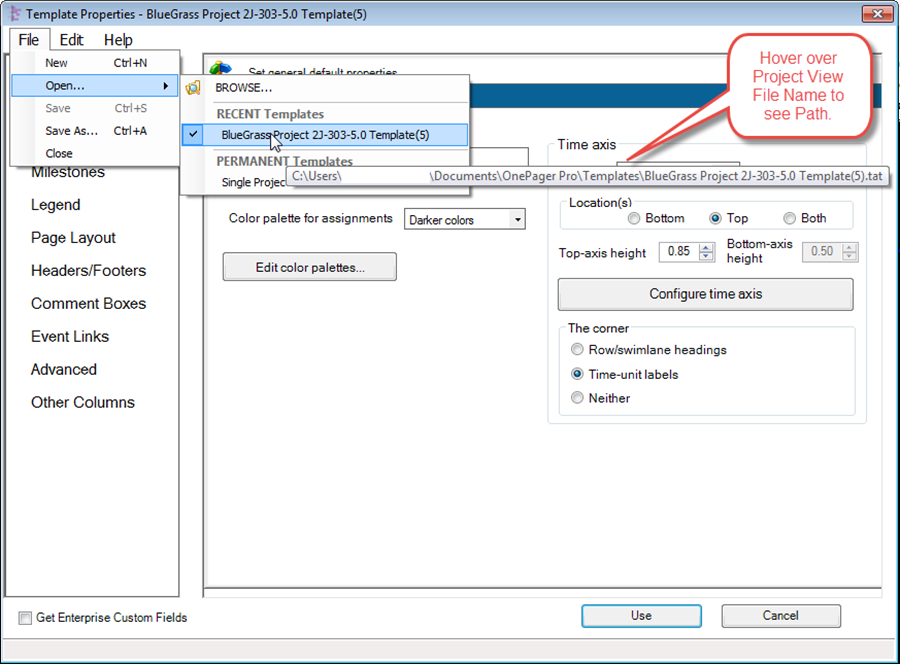
3) Hovering over a “RECENT Template” project view file name will reveal the path to the file.
4) To see your available templates, click the “BROWSE…” option in the “Open…” drop down menu to reveal the Microsoft Windows Explorer form showing your available templates:
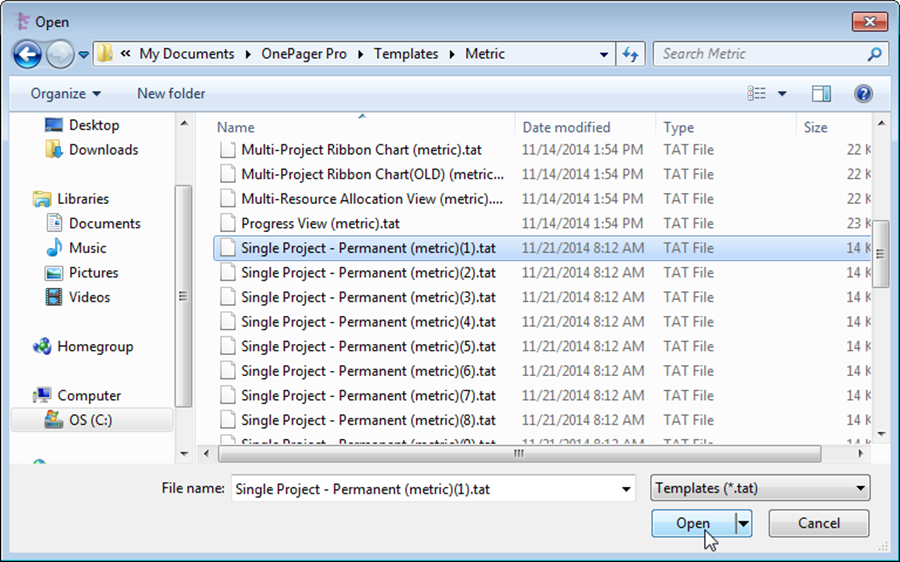
5) Select the template you need and then click the “Open” button. This will establish the selected template as the current template. Any new project views created from this point on will use this selected template.
Using the Selected Template
As discussed in the subsections above, after you have located the desired template and have the template form displayed on the screen, just click the “Use” button to close the form and use the template as the “Current Template:”
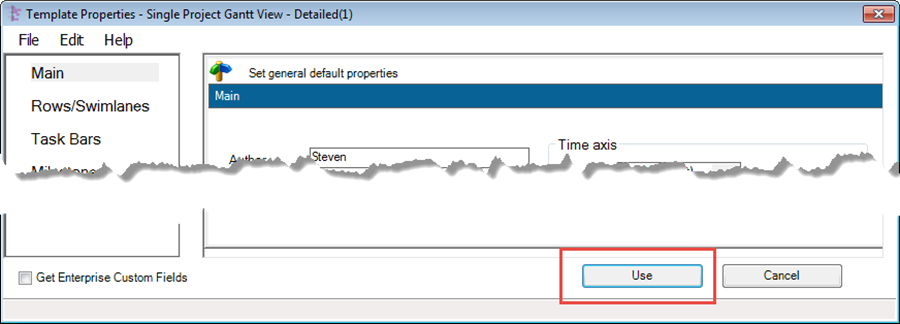
Or if you have edited the template or created a new template, click the “Save and Use” to use the template as the “Current Template:”
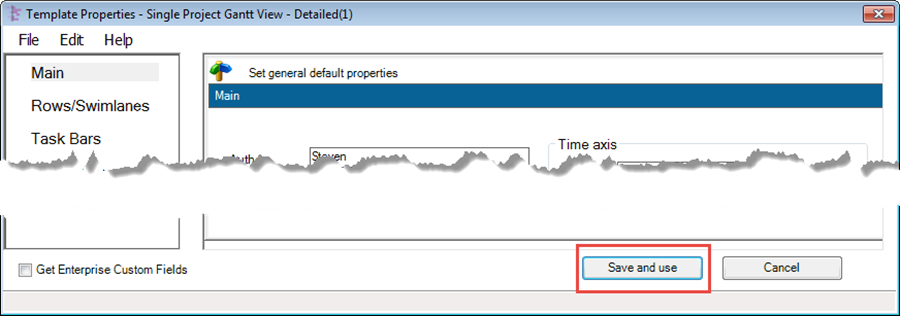
Creating a New Template and Saving the Template for Later Use
You may want to create a new template so that you can make the project view setting you need to support your presentations or to establish as standard in your organization. For the steps described below:
1) To create a new template, launch OnePager with the “Template…” button on the Microsoft Project tool bar. When the “Template Properties” form appears, select the “File” command and the click “New…” as shown here:
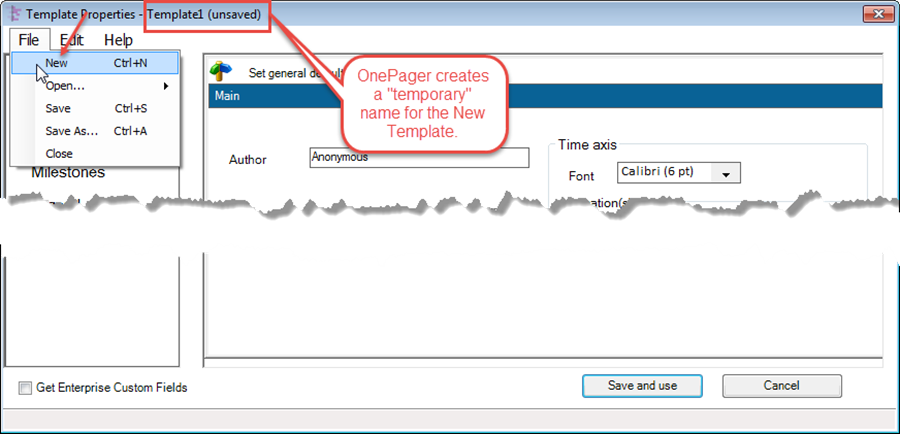
2) As shown above, clicking the “New” command in the “File” drop down will cause OnePager to create a temporary Template name and show that the template is “(unsaved).” At this point, with the new template displayed, go ahead and make your changes to the settings on one or more of the tabs of the “Template Properties” form.
3) When you are finished with your changes, you will need to save your new template give it a file name appropriate to the project or organization. To do this, again, click the “File” button on the “Template Properties” tool bar and then click either the “Save” or the “Save As…” options as shown below:
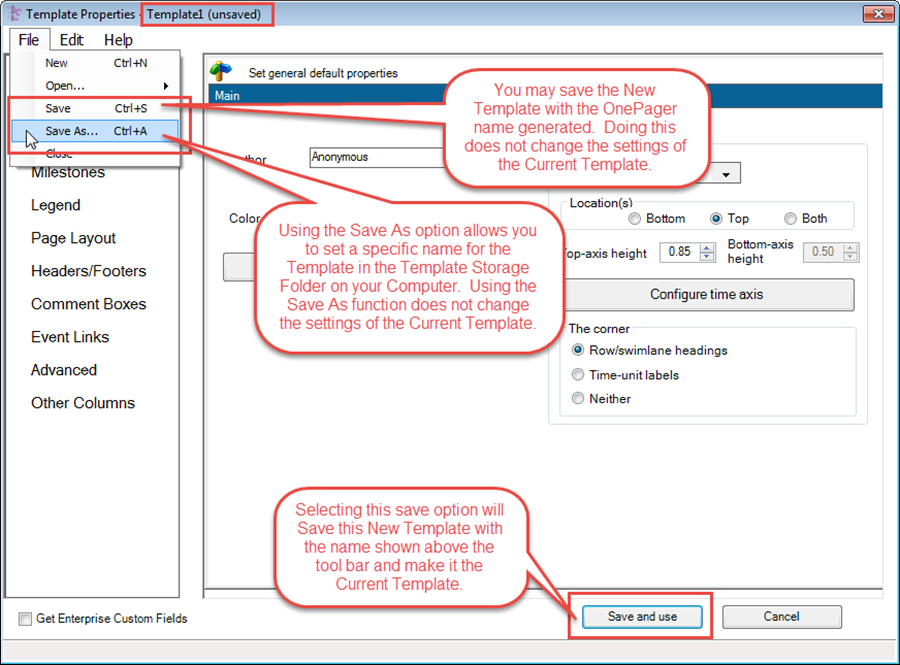
4) As mentioned above, you can save the template you’ve just created or modified either with the OnePager generated name or with a name of your choosing or you may save the template just created or changed with the OnePager generated name and make it the “Current Template” by clicking the “Save and use” button at the bottom of the form.
5) To save the new or modified template with your own file name, click the “Save As…” option in the “File” drop down. The Microsoft Windows Explorer “Save” form will appear and you can choose the file name and save the template as shown below:
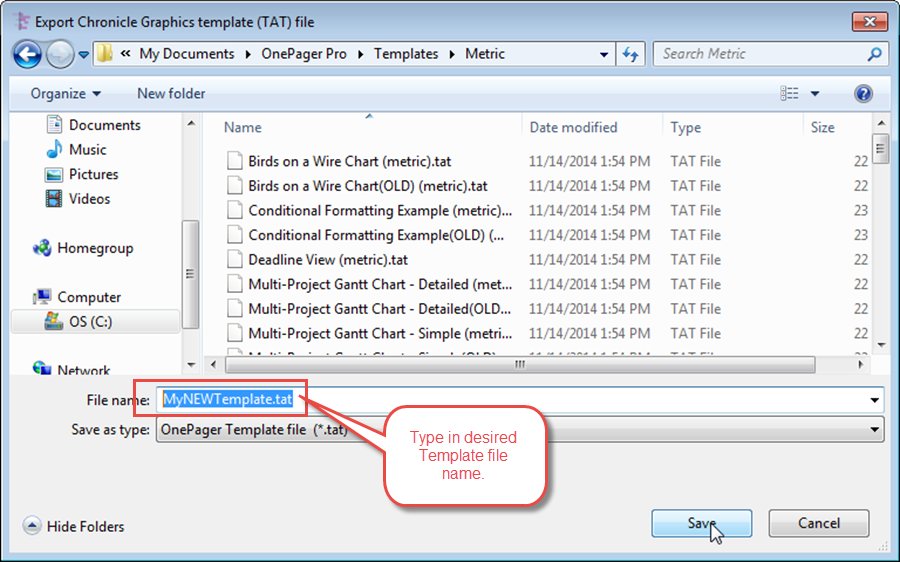
Making a Template from a Project View
Once you create an effective project view, you often would like to use those same settings to make a new project view for a different set of data from different Microsoft Project plans. Or you may want to let some other person emulate the project view as a new standard you just set. Just follow the steps outlined below:
1) This is easy to accomplish. Simply open the project view of interest and click the “Copy to Template” button command as shown below:

2) Clicking the “Copy to Template” button will bring up the OnePager “Export Chronicle Graphics Template” form for the folder where templates are stored as shown below:
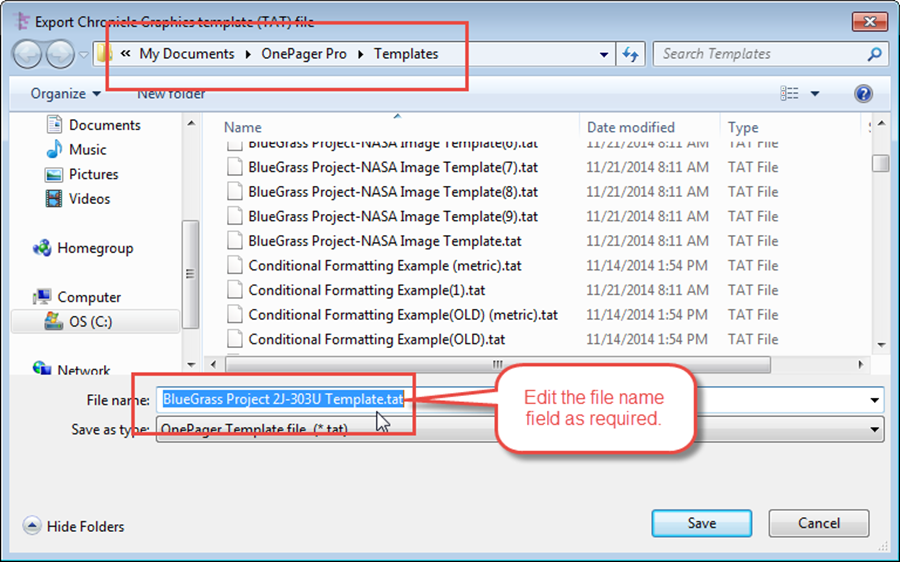
3) You may change the folder location for the new template and change the file name as desired. Click the “Save” button when editing is completed.
4) You can now use this new template to make “clones” of your project view with different data from other Microsoft Project plans. You can also send this template to other OnePager users by exporting the new template into a TAT file (see above).
Renaming a Template
You can rename a template file in the same way that you would rename any file supported by Microsoft Windows. Just follow the steps below:
1) First, use Microsoft Windows Explorer to go to the location where your template files are stored as shown below.
2) Select the file that you want to change and right click to reveal the drop down menu as shown below.
3) Click the “Rename” command which will highlight the selected file and allow you to make the name change in place. When you’ve changed the name to the desire template file name just click anywhere or close the Microsoft Windows Explorer window.
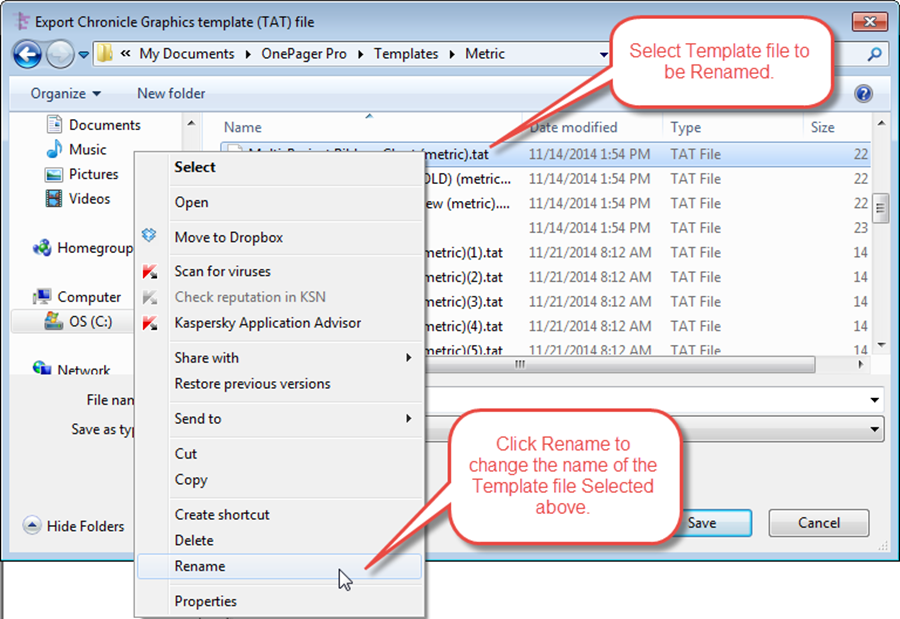
Deleting a Template
Deleting a template file may be done in the same way that any other Microsoft Windows file is deleted.
Locate the template file to be deleted in your file system, select the file to be deleted with a right-click and then select “Delete” and the file will be deleted as shown below:
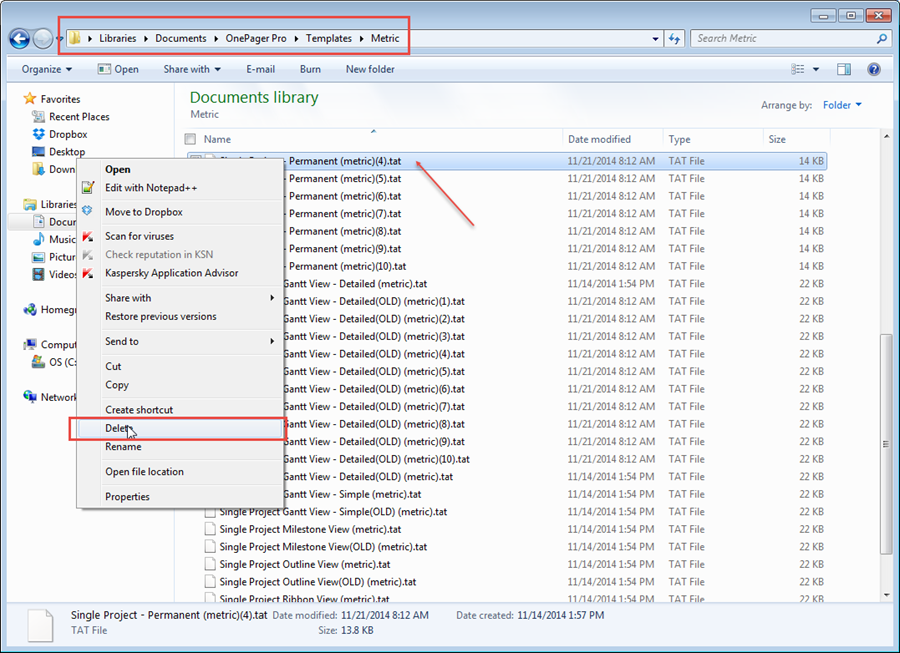
Including Images in Templates
For management of images associated with a template, click the “Template Properties” menu bar’s “Edit” button and the following menu is shown:
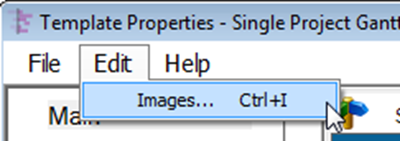
- a) Images. This gives you a list of Images that are included in the current template. If there are no images associated with the template, an information message appears as shown below:
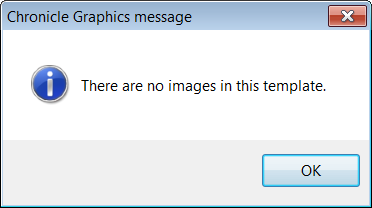
- b) Copy. To copy a template file to another location use the Windows Copy/Paste function to select the desired template file to be copied and paste the selected template file in the desired destination folder.
- c) Delete. Deleting a template file where ever it may reside is done by selecting the template file to be deleted with a right-click and using the “Delete” command in the Windows context menu to perform the delete function.
- d) Rename. As with copy and delete you may use the Windows Rename command to perform this function. Select the template file to be renamed with a long double left-click such that the name field is available for editing. Then edit the template’s file name and deselect the template file.
Including Logos in a Template
You may want to put standard images such as company logos into a template so that you and others can build graphs that have standard company elements in them. To do this, follow the steps below:
1) Put the logo and other images into a project view as described elsewhere in this document and then turn that project view into a template as described in the previous section
2) You can verify that the images are indeed part of the template by examining its image content. To do this click the “Templates…” button which brings up the “Template Properties” form and go to the “Edit” button and click the “Images…” command as shown here:
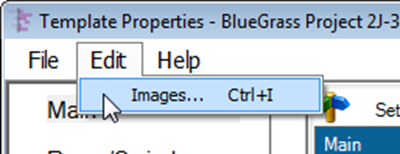
3) When you click this, you will see a report of which images are in your template:
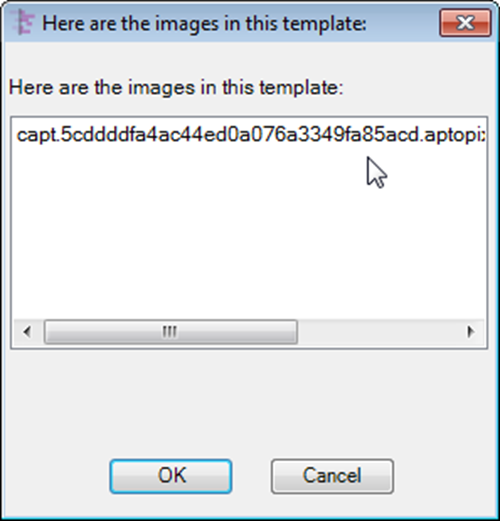
4) You can view these images at any time using the template to make a new project view.
5) To delete an image from the template simply select an image to be deleted from the images listed in the “Here are the images in this template” form shown above with the mouse (left-click) and press your keyboard’s Delete Key. This will permanently delete the image from the template.
6) UNDO will NOT retrieve the image after the keyboard’s delete key is pressed.
(24.6)